| dc.contributor.author | Chmielowiec, Brian John | |
| dc.contributor.author | Fujimura, Tatsuki | |
| dc.contributor.author | Otani, Tomohiro | |
| dc.contributor.author | Aoyama, Kiego | |
| dc.contributor.author | Nohira, Toshiyuki | |
| dc.contributor.author | Homma, Takayuki | |
| dc.contributor.author | Fukunaka, Yasuhiro | |
| dc.contributor.author | Allanore, Antoine | |
| dc.date.accessioned | 2021-08-09T17:30:07Z | |
| dc.date.available | 2021-08-09T17:30:07Z | |
| dc.date.issued | 2019-06 | |
| dc.date.submitted | 2019-04 | |
| dc.identifier.issn | 0013-4651 | |
| dc.identifier.issn | 1945-7111 | |
| dc.identifier.uri | https://hdl.handle.net/1721.1/131147 | |
| dc.description.abstract | Current interrupt and galvanostatic EIS techniques were utilized in a complementary fashion to characterize the different sources of overpotential during anodic gas evolution. Room temperature anodic evolution of oxygen at a nickel working electrode in aqueous potassium hydroxide and the high temperature (348°C) anodic evolution of chlorine at a glassy carbon working electrode in molten (LiCl)[subscript 57.5-](KCl)[subscript 13.3-](CsCl)[subscript 29.2 ] where investigatd. Combining of the two techniques enables to separate the total measured overpotential into its ohmic, charge transfer, and mass transfer components. Potential decay curves indicated that natural convection (due to both bubble evolution and density driven flow) was a major driving force in reestablishing equilibrium conditions at the working electrode surface. During oxygen evolution, charge transfer resistance dominated the total overpotential at low current densities, but as the current density approached ~100mA/cm[superscript 2], mass transfer overpotentials and ohmic overpotential became non-negligible. The mass transfer overpotential during chlorine evolution was found to be half that found during oxygen evolution. | en_US |
| dc.description.sponsorship | Naval Research (Contract N00014-12-1-0521) | en_US |
| dc.language.iso | en | |
| dc.publisher | The Electrochemical Society | en_US |
| dc.relation.isversionof | http://dx.doi.org/10.1149/2.1001910jes | en_US |
| dc.rights | Creative Commons Attribution-NonCommercial-NoDerivs License | en_US |
| dc.rights.uri | http://creativecommons.org/licenses/by-nc-nd/4.0/ | en_US |
| dc.source | Prof. Allanore | en_US |
| dc.title | Experimental Measurement of Overpotential Sources during Anodic Gas Evolution in Aqueous and Molten Salt Systems | en_US |
| dc.type | Article | en_US |
| dc.identifier.citation | Chmielowiec, Brian John et al. "Experimental Measurement of Overpotential Sources during Anodic Gas Evolution in Aqueous and Molten Salt Systems." Journal of The Electrochemical Society 166, 10 (June 2019): E323. © 2019 The Author(s) | en_US |
| dc.contributor.department | Massachusetts Institute of Technology. Department of Materials Science and Engineering | en_US |
| dc.contributor.department | MIT Materials Research Laboratory | en_US |
| dc.relation.journal | Journal of The Electrochemical Society | en_US |
| dc.eprint.version | Final published version | en_US |
| dc.type.uri | http://purl.org/eprint/type/JournalArticle | en_US |
| eprint.status | http://purl.org/eprint/status/PeerReviewed | en_US |
| dc.date.updated | 2019-09-05T13:04:31Z | |
| dspace.date.submission | 2019-09-05T13:04:33Z | |
| mit.journal.volume | 166 | en_US |
| mit.journal.issue | 10 | en_US |
| mit.license | OPEN_ACCESS_POLICY | |
| mit.metadata.status | Complete | |

